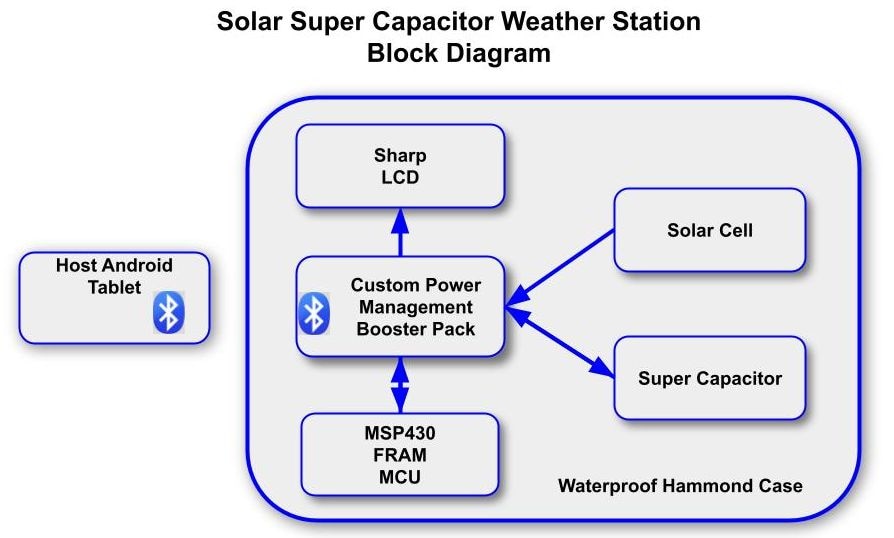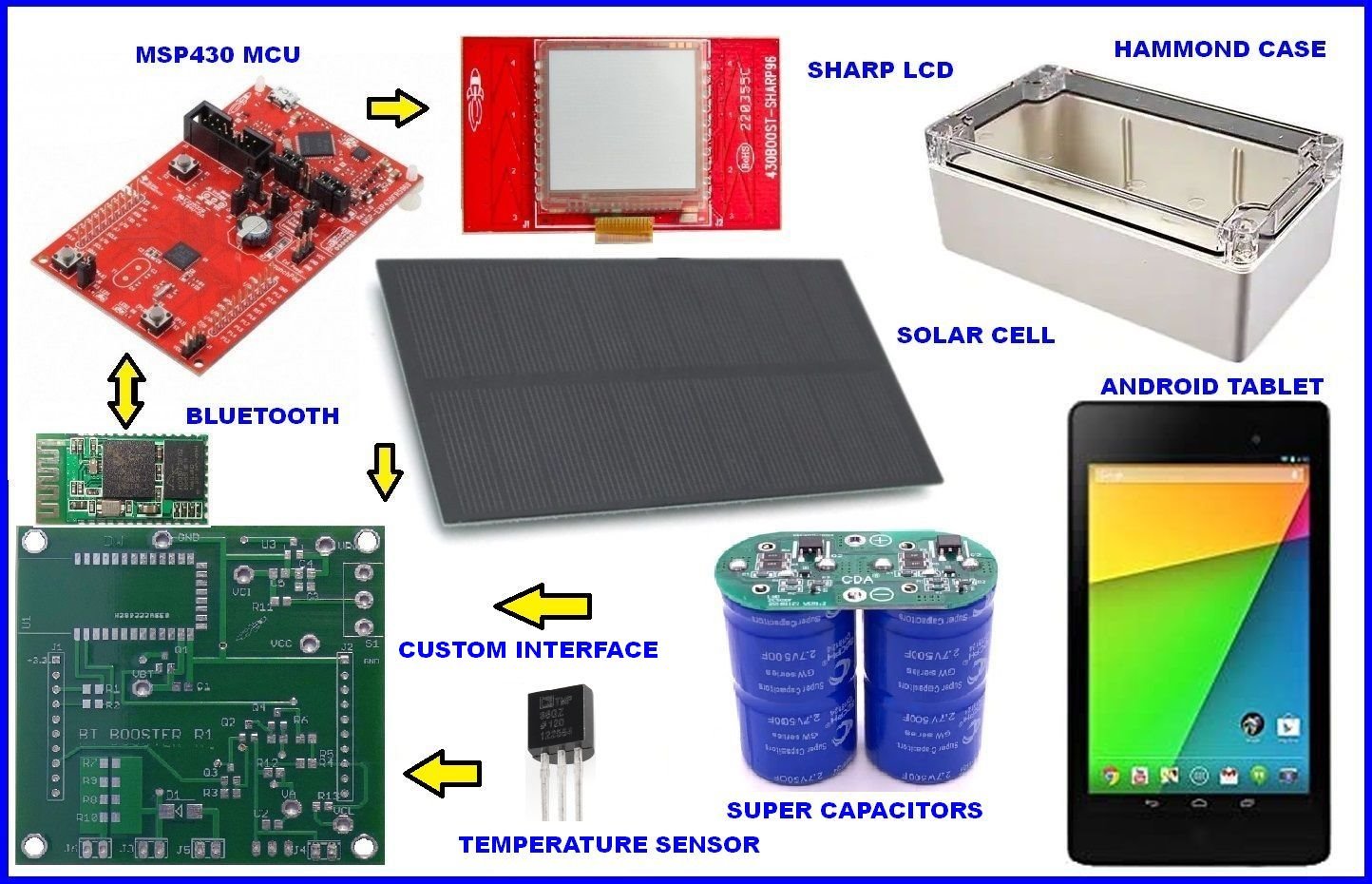Background Rationale
Sunlight is well on its way to becoming the major source of electrical power on the planet, and I want to learn more about the important technologies involved in this global paradigm shift. One way to help with this objective is to start doing more solar projects and become more familiar with the practical issues and technology capabilities.
Another motive for me is that I really, really do not like batteries, despite their utility and ubiquity, and I want to migrate as many applications away from batteries as I can. Aside from personal preferences and replacement costs, batteries (lithium, alkaline and NiMH) are not rated to work at -40 degrees and it is quite possible to see these low temperatures where I live. If you try these batteries at -40 anyway, their performance may be severely degraded. Most super capacitors are rated to work at -40 degrees.
Solar energy of course has a big drawback in not being available at night, but the main purpose of this project is to to experiment with super capacitor technology to see if it can overcome this problem and store enough charge to allow a simple microcontroller application to run all night.
Objectives
- investigate how solar cells and super capacitors work and learn about their system requirements and performance capabilities
- design and build a solar power supply that uses super capacitors which is capable of running a microcontroller 24 hours a day without batteries
- design a schematic plus PCB layout and assemble a PCB that can manage power and sensor interfaces for the solar sensor system
- design and build a microcontroller system that can monitor temperature and relay it via Bluetooth to a remote host
- design the system interconnect circuit diagram
- package the electronics in a waterproof case that can protect the electronics through winter and summer weather
- write test firmware to show temperature and power system status on the LCD
- design and program firmware to read temperature, send it via Bluetooth and manage power consumption day and night
- design and program host Bluetooth software to display temperature data from the outdoor solar powered system
- blog about the project

System Components
Research Plan
Investigate how to protect super capacitors from over voltage when used in series.
Investigate performance of super capacitors at very cold temperatures
Determine how much current the solar cell can supply under various lighting conditions.
Determine how much current the MCU and its peripherals require in each mode of operation.
Calculate how large the super capacitors need to be to last all night.
Calculate how well the chosen super capacitors will be able to keep the system working overnight.
Design Plan
- design the solar power supply schematic including super capacitors and their power sharing circuitry
- add the temperature sensor, Bluetooth radio and connector systems to the schematic
- design the PCB layout to fit the standard Booster Pack connector pinout and form factor
- design the system interconnect circuit diagram
- design test firmware to show temperature and power system status on the LCD
- design firmware to read temperature and monitor power supply status and send it via Bluetooth
- design host Bluetooth software to display temperature data received via Bluetooth
Build Plan
Assemble the custom power management PCB
Connect the MCU, LCD and custom Booster Pack
Write test firmware to show temperature and power system status on the LCD
Write test firmware to get Bluetooth communications working
Write final MCU firmware to monitor temperature and power supply status and send them via Bluetooth
Test Plan
Measure performance of the solar cell under various lighting conditions
Test super capacitor voltage sharing and capacity performance
Check proper connection of power supply to all circuitry and do a power up test
Load test software and debug any firmware and hardware issues
Test performance of the system running from super capacitors
Test host app
Documentation Plan
- performance of the solar cell
- performance of the supper capacitors
- power requirements of the system and power saving techniques used
- system performance - power consumption versus update rates, Bluetooth range
- blogs, videos, images, conclusions
Project Status
This blog outlines the project concept and its objectives, including a simple block diagram. It also includes a short video showing a solar cell test - to keep this blog from being too dry.
- The research plan is essentially complete although it is not fully documented.
- The conceptual design is complete, but again documentation is lacking, and the main components have been selected and ordered - most have arrived, although there are still a couple of key components in transit. Omicron seems to have totally stalled some parts of the supply chain, in this case the mail system. Hopefully is clears up a bit soon.
- The custom Booster Pack schematic design is complete
- The custom Booster Pack PCB layout is complete (and PCBs have been manufactured)
- Preliminary solar cell performance testing is complete
Solar Cell Specifications
Solar panels color: Black
Technology: Epoxy solar panels
Maximum power: 1.65 W
Operating current: 300mA
Operating voltage: 5.5V
Open circuit voltage: 6.2 V
Short circuit current: 330mA
Size: 133*76mm
Solar Cell Performance
| Voltage | Current | Lighting Conditions |
| 5 V | 2 mA | Bright Indoor Lighting |
| 5 V | 5 mA | Very Bright Indoor Lighting |
| 4.7 V | 47 mA | 20 degree winter sunlight |
| 6.7 V | 67 mA | 90 degree winter sunlight |
| 5 V | 137 mA | 90 degree winter sunlight |
| 3.7 V | 1 mA | Overcast just after sunset |
Power Requirements
MCU : < 1 mA @ 3.3 V (with LCD running)
Bluetooth ~ 30 mA @ 3.3V when active
Next Step
The next blog will cover detailed design of the system and circuitry and discuss super capacitor design issues.
Relevant Links
Just Encase Solar Super Capacitor Experiment - Blog 1
Just Encase Solar Super Capacitor - Project Outline - Blog 2
Just Encase Super Capacitor Solar Weather Station - Design - Blog 3
Just Encase Super Capacitor Solar Weather Station - Assembly - Blog 4
Just Encase Super Capacitor Solar Weather Station - Bluetooth - Blog 5
Just Encase Super Capacitor Solar Weather Station - Indoor Operation - Blog 6
Just Encase Solar Super Capacitor Weather Station - Outdoor Tests - Blog 7
Just Encase Design Challenge
Tube Amp using Hammond transformers
GPS location and distance tracking using LoRa on a MKR WAN 1300
